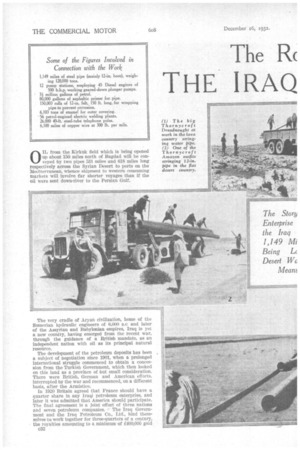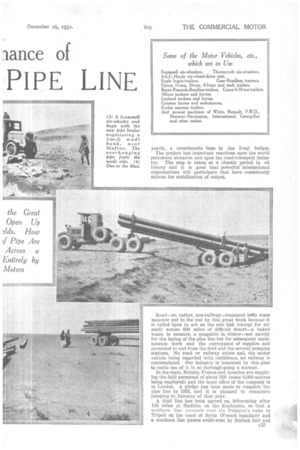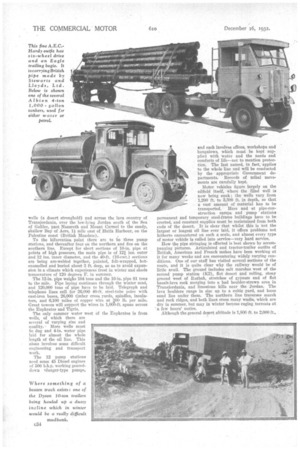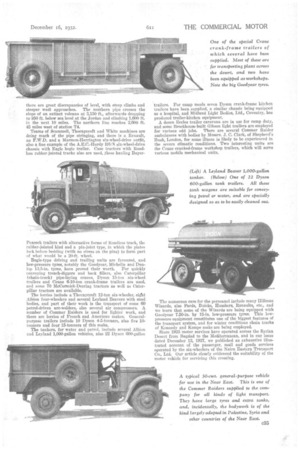The .R( lance of
Page 78

Page 79

Page 80

Page 81

If you've noticed an error in this article please click here to report it so we can fix it.
THE IRAQ
PIPE LINE
0 IL from the Kirkuk field which is being opened up about 150 miles north of Bagdad will be conveyed by two pipes 531 miles and 618 miles long respectively across the Syrian Desert to ports on the Mediterranean, whence shipment to western consuming markets will involve far shorter voyages than if the oil were sent down-river to the Persian Gulf.
The very cradle of Aryan civilization, home of the Sumerian hydraulic engineers of 6,000 B.0 and later of the Assyrian and Babylonian empires, Iraq is yet a new country, having emerged from the recent war. through the guidance of a British mandate, as an independent nation with oil as its principal natural resource.
The development of the petroleum deposits has been a subject of negotiation since 1901, when a prolonged international struggle commenced •to obtain a concession from the Turkish Government, which then looked on this land as a province of but small consideration. There were British, German and American efforts. interrupted by the war and recommenced, on a different basis, after the Armistice.
In 1920 Britain agreed that France should have a quarter share in any Iraqi petroleum enterprise, and later it was admitted that America should participate. The final agreement is a joint effort of three nations and seven petroleum companies. s' The Iraq Government and the Iraq Petroleum Co., Ltd., bind themselves to work together for three-quarters of a century. the royalties amounting to a minimum‘of f400,000 gold c32 yearly, a considerable item in the Iraqi budget. The project has important reactions upon the world petroleum situation and upon the road-transport industry. The step is taken at a chaotic period in oil history and it is good that powerful international organizations will participate that have consistently striven for stabilization of output.
Road—or, rather, non-railway—transport is.A.'m some measure put to the test by this great work because it is called upon to act as the sole link (except for air mail) across 600 miles of difficult desert—a baked waste in slimmer, a quagmire in, winter—not merely for the laying of the pipe line but for subsequent maintenance work and the conveyance of supplies and personnel to and from the field and the several pumping stations. No road or railway exists and, the Motor vehicle being regarded With confidence, no railway is contemplated. Our industry is honoured by this plan to make use of it in so thorough-going a manner In the main, Britain, France and America are supplying the field personnel of about 500 (some 6,000 natives being employed) and the head office of the company is in London. A pledge has been made to complete the pipe line by 1935, and it is planned to commence pumping du January of that year.
A dual line has been agreed on, bifurcating after 150 miles at Haditha on the Euphrates, so that a northern line proceeds west via Pahnyra's ruins to Tripoli on the coast of Syria (French mandate) and a southern line passes south-west by Rutbah fort and
wells (a desert stronghold) and across the lava country of Trausjordania, over the low-lying Jordan south of the Sea of Galilee, past Nazareth and Mount Carmel to the sandy, shallow Bay of Acre, 1 mile east of Haifa Harbour, on the Palestine coast (British Mandate).
To the bifurcation point there are to be three pump stations, and thereafter four on the northern and five on the southern line. Except for short sections of 10-in, pipe at points of high pressure, the main pipe is of 12/ ins, outer and 12 ins, inner diameter, and the 40-ft. (16-cwt.) sections are being arc-welded together, painted, felt-wrapped, hotenamelled and buried about 3 ft. deep, so as to avoid expansion in a climate which experiences frost in winter and shade temperature of 120 degrees F. in summer.
The 12-in, pipe weighs 104 tons and the 10-in. pipe 81 tons to the mile. Pipe laying continues through the winter mud, and 120,000 tons of pipe have to be laid. Telegraph and telephone lines call for 26,000 40-ft. steel-tube poles with cast-iron bases, 26,000 timber cross yards, spindles, insulators, and 6,100 miles of copper wire at NO lb. per mile. Great towers will support the wires in 1,000-ft. spans across the Euphrates and Tigris.
The only summer water west of the Euphrates is from wells, of which there are several of varying size and quality. More wells must be dug and 4-in, water pipe laid for almost the whole length of the oil line. This alone involvessome difficult engineering and transport work.
The 12 pump stations need some 45 Diesel engines
of 500 b.h.p. working geareddown ulunger-type pumps,
and each involves offices, workshops and bungalows, which must be kept supplied with water and the needs and comforts of life—not to mention protection. The last named, in fact, applies to the whole line and will be conducted by the appropriate Government departments. Records of tribal movements are carefully kept.
Motor vehicles figure largely on the oilfield itself, where the 32nd well is now being sunk ; the wells vary from 1,200 ft. to 3,300 ft. in depth, so that a vast amount of material has to be transported. Here and at pipe-construction camps and pump stations permanent and temporary steel-frame buildings have to be erected, and constant supplies must be maintained from both ends of the desert. It is clear that whilst this is not the largest or longest oil line ever laid, it offers problems not hitherto encountered on such a scale, and almost every type of motor vehicle is called into service—very hard service.
How the pipe stringing is effected is best shown by accompanying pictures. Articulated and tractor-trailer outfits of British, American and French makes have been working at it for many weeks and are encountering widely varying conditions. One of our staff has visited several sections of the route, and it is quite clear why the railway would be of little avail. The ground includes salt marshes west of the second pump station (K2), flat desert and rolling, stony ground west of Rutbah, stretches of gypsum and of flat basalt-lava reek merging into a bad boulder-strewn area in Transjordania, and limestone hills near the Jordan. The lava boulders range in size up to a cubic yard, and loose sand lies under them. The northern line traverses marsh and rock ridges, and both lines cross many wadis, which are dry in summer, but may in winter become raging torrents at ' a few hours' notice.
Although the general desert altitude is 1,800 ft. to 2000, ft.,
there are great discrepancies of level, with steep climbs and steeper wadi approaches. The southern pipe crosses the slope of an extinct volcano at 3,150 ft, afterwards dropping to 850 ft. below sea level at the Jordan and climbing 1,600 ft. in the next 10 miles. The northern line reaches 2,600 ft. 45 miles west of station T4.
Teams of Scammell, Thornycroft nnii White machines are doing much of the pipe stringing, and there is a Renault, an F.W.D. and a Marmon-nerrington six-wheel-drive outfit, also a fine example of the A.E.C.-Ilardy R6/8 six-wheel-drive chassis with Eagle bogie trailer. Case tractors with Roadless rubber-jointed tracks also are used, these hauling Bayer
Peacock trailers with alternative forms of Roadless track, the rubber-jointed kind and a pin-joint type, in which the plates lock before bedding (with no stress on the pins) to form part of what would be a 20-ft. wheel.
Bogie-type driving and trailing units are favoured, and low-pressure tyres, notably the Goodyear, Michelin and Dunlop 13.5-in. tyres, have proved their worth. For quickly conveying trench-diggers and back fillers, also Caterpillar (chain-track) pipe-laying cranes, Dyson 15-ton six-wheel trailers and Crane 6-10-ton crank-frame trailers are used, and some 70 McCormick-Deering tractors as well as Caterpillar tractors are available.
The lorries include a Thernycroft 12-ton six-wheeler, eight Albion four-wheelers and several Leyland Beavers with steel bodies, and part of their work is the transport of some 60 petrol-driven are-welders, also several air compressors. A number of Commer Raiders is used for lighter work, and there are lorries of French and American makes. Generalpurpose trailers include 10 Dyson 4-5-tonners, also five 10twitters and four 15-tonners of this make.
The tankers, for water and petrol, include several Albion and Leyland 1,000-gallon vehicles, also 22 Dyson 600-gallon 'trailers. For camp meals seven Dyson crank-frame kitchen trailers have been supplied, a similar chassis being equipped as a hospital, and Midland Light Bodies, Ltd., Coventry, has produced trailer-kitchen equipment. A dozen Eccles trailer caravans are in use for camp duty, and some Brockhouse-built Gibson light trailers are employed for various odd jobs. There are several Commer Raider ambulances with bodies by Messrs. 3. C. Clark, of Shepherd's Bush, London, for some illness is likely to be experienced in the severe climatic conditions. Two interesting units are the Crane cranked-frame workshop trailers, which will serve various mobile mechanical units.
The numerous cars for the personnel include many Hillman Wizards, also Yards, Buicks numbers, Renaults, etc., and we learn that some of the Wizards are being equipped with Goodyear 7.50-in. by 15-in, low-pressure tyres. This lowpressure equipment constitutes one of the biggest features of the transport system, and for winter conditions chain tracks of Kennedy and Kempe make are being employed. Since 1923 motor, services have openated across the Syrian Desert from Bagdad to the Mediterranean, and in our issue dated December 13, 1927, we published an exhaustive illustnated account of the passenger, mail and goods services operated by the six-wheelers of the Nairn Eastern Transport Co., Ltd. Our article clearly evidenced the suitability of the motor vehicle for servicing this crossing.




























































































































































